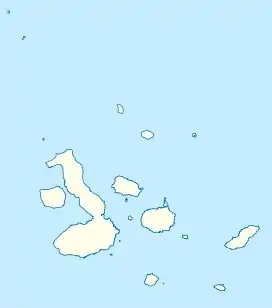 North Seymour Island | |
| Geography | |
|---|---|
| Location | Galápagos Islands, Ecuador |
| Coordinates | 0°23′44″S 90°17′14″W / 0.395592°S 90.287327°W |
| Archipelago | Galápagos Islands |
| Highest elevation | 28 m (92 ft) |
| Administration | |

North Seymour Island (Spanish: Isla Seymour Norte) is a small island near Baltra Island in the Galápagos Islands in Ecuador. It was formed by uplift of a submarine lava formation and is now covered with low, bushy vegetation. It has an area of 1.9 km2 (0.73 sq mi) and a maximum elevation of 28 meters (92 ft). There is no permanent population but a visitor trail has been established approximately 2 km (1.2 mi) in length for guided tours crossing the interior of the island and exploring the rocky coast.
Name
Seymour Island was charted c. 1794 by British captain James Colnett in honor of the capable officer Hugh Seymour,[1] later promoted to vice admiral for his service during the Napoleonic Wars. Its present name North Seymour distinguishes it from nearby Baltra Island, previously known as South Seymour.[1] Together with Baltra, North Seymour is still sometimes reckoned as part of the Seymours or the Seymour Group.
Geography
North Seymour is an islet near Baltra in Ecuador's Galápagos Islands.[2] It was formed by seismic uplift of a submarine lava formation rather than directly created by volcanism. The island has a flat profile with cliffs only a few meters from the shoreline.
Flora
All of North Seymour is covered with low, bushy vegetation.[3] A tiny forest of silver-grey Palo Santo trees stand just above the landing, usually without leaves.
Wildlife
North Seymour is home to a large population of blue-footed boobies and swallow-tailed gulls. Flocks of pelicans and swallow-tailed gulls feed off shore, and seasonally, Nazca boobies can also be seen.
There is a slowly growing population of Galápagos land iguanas (Conolophus subcristatus). The stock for the captive breeding program of the Galápagos land iguana is descended from iguanas which Captain G. Allan Hancock moved from nearby Baltra Island in the 1930s. This helped preserve the species when Baltra became the site of an American airbase during World War II. The population swelled to over 5,000 by the 21st century, beginning to reach the limits of the island's food availability. The Directorate of the Galápagos National Park and Island Conservation took 1,436 of the iguanas from the North Seymour population to Santiago Island on 4 January 2019, restoring them to Santiago after a 180-year absence in an effort to restore that island's ecological health and to provide the both groups of iguanas more resources to thrive. Darwin had noted Santiago's iguanas in 1835, but they were last found there by Abel-Nicolas Bergasse du Petit-Thouars in 1838.[4][5][6][7][8][9]
On January 12, 2019, the park directorate began using aerial drones to eradicate black and brown rats (Rattus rattus and R. norvegicus) from North Seymour, the first time such an approach had been used on vertebrates in the wild. The expectation is that this innovation will pave the way for faster and cheaper eradications of invasive species in the future on small and mid-sized islands.[10][11][12][13]
Gallery
 A Galápagos land iguana on the North Seymour Island in the Galápagos
A Galápagos land iguana on the North Seymour Island in the Galápagos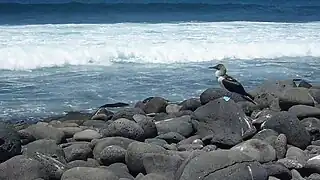 (Sula nebouxii) blue footed booby on North Seymour Island Galápagos
(Sula nebouxii) blue footed booby on North Seymour Island Galápagos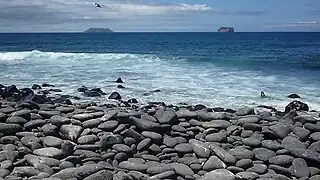 Beach in North Seymour Island, Galápagos
Beach in North Seymour Island, Galápagos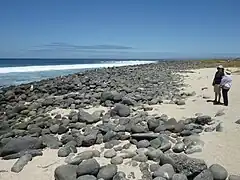 Long view of the beach on North Seymour Island, Galápagos
Long view of the beach on North Seymour Island, Galápagos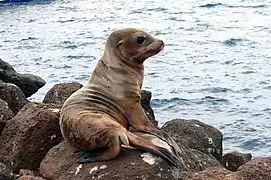 Galápagos sea lion (Zalophus wollebaeki)
Galápagos sea lion (Zalophus wollebaeki)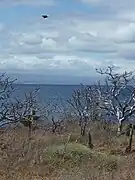 North Seymour Island in the Galápagos
North Seymour Island in the Galápagos North Seymour Island Galápagos seal with baby
North Seymour Island Galápagos seal with baby North Seymour Island in the Galápagos about to land on shore. Daphne Island is in the distance.
North Seymour Island in the Galápagos about to land on shore. Daphne Island is in the distance. North Seymour Island in the Galápagos, Daphne Island is in the distance.
North Seymour Island in the Galápagos, Daphne Island is in the distance.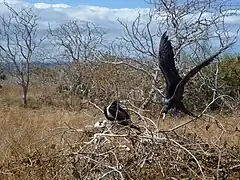 North Seymour Island in the Galápagos, a bird in flight
North Seymour Island in the Galápagos, a bird in flight North Seymour Island in the Galápagos
North Seymour Island in the Galápagos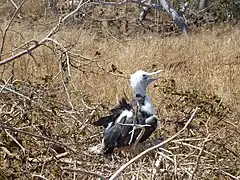 A baby bird at North Seymour Island in the Galápagos
A baby bird at North Seymour Island in the Galápagos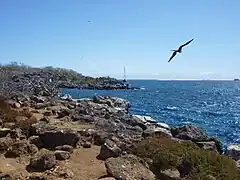 Magnificent frigatebird (Fregata magnificens) in flight on the coast of North Seymour Island in the Galápagos
Magnificent frigatebird (Fregata magnificens) in flight on the coast of North Seymour Island in the Galápagos_North_Seymour_Island_Galapagos.JPG.webp) Magnificent frigatebird, North Seymour Island
Magnificent frigatebird, North Seymour Island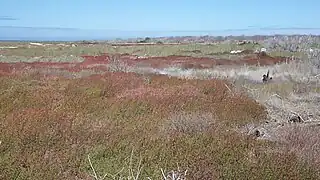 North Seymour Island
North Seymour Island The beach at North Seymour Island in the Galápagos North. Daphne Island is in the distance.
The beach at North Seymour Island in the Galápagos North. Daphne Island is in the distance.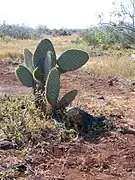 North Seymour, Galapagos, land iguana
North Seymour, Galapagos, land iguana
References
Citations
- 1 2 McEwen (1988), p. 238.
- ↑ "North Seymour". Galapagos Conservancy. galapagos.org. Retrieved 2 June 2017.
- ↑ "NORTH SEYMOUR ISLAND, GALAPAGOS". Animal Corner. animalcorner.co. Retrieved 2 June 2017.
- ↑ "Threatened Galápagos Land Iguanas Return to Santiago Island En-Masse After 180-Year Absence". Island Conservation. Retrieved 9 January 2019.
- ↑ "Galápagos island gets its first iguanas since Darwin after mass-release". The Guardian. Retrieved 9 January 2019.
- ↑ "Iguanas reintroduced to Galapagos island after 200 years". CNN.com. Retrieved 9 January 2019.
- ↑ "Iguanas Are Being Reintroduced to a Galapagos Island Two Centuries After They Disappeared". TIME. Retrieved 9 January 2019.
- ↑ "Iguanas reintroduced to Galapagos island after almost 200 years". The Independent. Archived from the original on 21 June 2022. Retrieved 9 January 2019.
- ↑ "Iguanas Reintroduced to the Largest Galapagos Island After Nearly 200 Year Absence". Earther. Retrieved 9 January 2019.
- ↑ "Ecological Restoration of North Seymour Island Underway Thanks to Rat Removal". Island Conservation. Retrieved 23 January 2019.
- ↑ "Drones unleashed against invasive rats in the Galápagos". Nature. Retrieved 23 January 2019.
- ↑ "Drones help Galapagos tackle rat infestation". BBC. Retrieved 31 January 2019.
- ↑ "Drones drop poison bombs to fight one island's rat invasions". Wired. Retrieved 23 January 2019.
Bibliography
- McEwen, Alec (July 1988), "The English Place-Names of the Galápagos", The Geographical Journal, vol. 154, London: Royal Geographical Society, pp. 234–242, doi:10.2307/633849, JSTOR 633849.